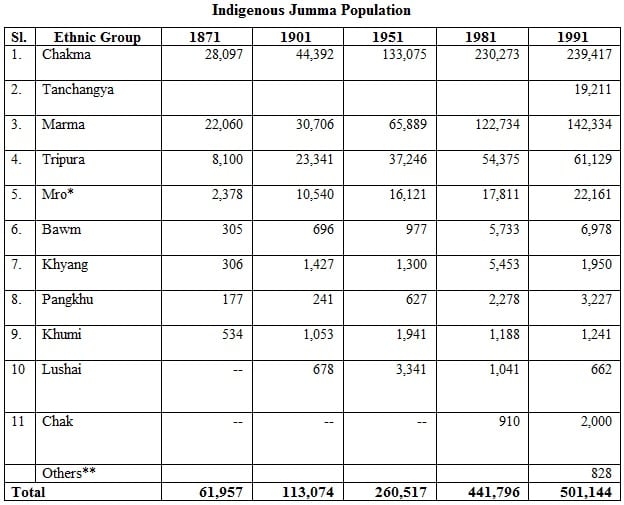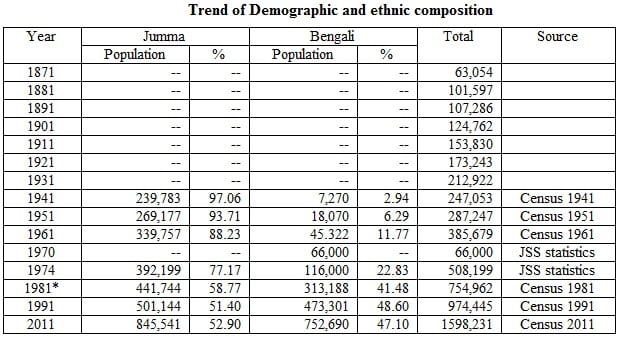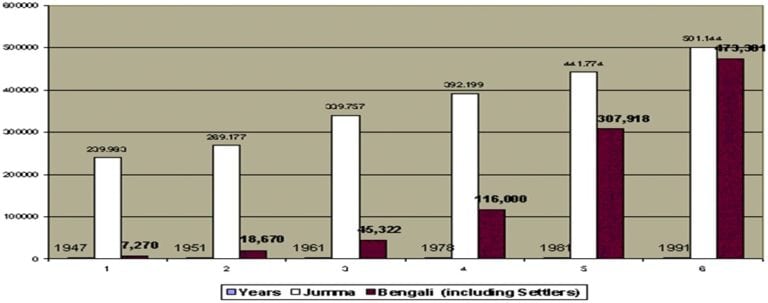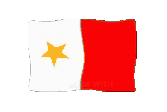The peoples of Chittagong Hill Tracts (CHT) are totally different from rest of the majority population of Bangladesh in all respects that feature ‘a people’ with regard to social, economic, cultural, so on and so forth. It is a land of at least 11 multilingual indigenous peoples consisting of Chakma, Marma, Tripura, Mro, Bawm, Pangkhu, Khyang, Khumi, Chak, Lushai, Tanchangya including Assamese, Gurkha and Saontals, collectively known as Jumma. The indigenous Jumma peoples mainly practice Buddhism, Hinduism and Christianity as their religion. Each group has distinctly different language, culture, religions, tradition, customs, practices, and lifestyle but still then they lead a common culture of livelihood. In spite of all this, the indigenous peoples have been living in peaceful co-existence with their traditional economic system and develop their own socio-economic-cultural and political system under the umbrella of their traditional “Jum economy”.
The indigenous Jumma peoples are of Mongoloid origin belonging to the Tibeto-Burman or Mon-Khmer group although there are some Indo-Aryan traces visible in them. The original languages of the different ethnics groups belong to the various branches of different language families. Mr. G A Grierson mentioned that the languages of Bawm, Chakma, Khumi, Khyang, Lushai, Marma, Mro, Pangkhu, Chak, Tanchangya are Kuki-Chin branch of Tibeto-Burmese family. Kokbarak (Tripura) language is Bodo branch of Tibeto-Burmese family. The Chakma and Marma have own scripts.

Source: An Evaluation of Integrated Community Development Programme for the CHT
* Census report of 1991 mentions Mro population were 22,041 and Murang 126. In fact, they are same ethnic group.
** Census report of 1991 does not mention clearly about others. Of course, there are included 70 population of Rakhaine.
Trend of Demographic Indication
During the partition of India and Pakistan, the total population of Chittagong Hill Tracts was only 247,053 out of that only 2.5 percent Bengali including 1.5 percent Bengali Muslims. But after 20 years of Pakistan Period and 31 years of the Bangladesh period, the picture of the demography of CHT has significantly changed specially after the systematic illegal settlement of Bengali Muslims by the successive governments.
Noted the more than 450,000 Bengali Muslims from the plain districts of the Bangladesh has illegally been given settlement in CHT by the government of Bangladesh in 1980s. So, presently according the Bangladesh census report 2000 the total population of the CHT is 1,325,000. Noted that the total figure is including ethnic Bengali and settlers and also many numbers of Bengali settlers are excluded in the time of census. It is estimated that the population of the Jumma will be around 700,000. According to the census report of 1991, total population was 974,445 (including ethnic Bengali and settlers) out of that 501,144 were Jumma and 473301 were Bengali (means 49% of total Population).

* In 1981:
(1) Total Hindu population (Bengali & Tripura) is 69,802 and Tripura 58,385. Therefore, actual Bengali Hindu population is 11,417.
(2) Total Bengali population (Muslim & Hindu) is 313,188 and Bengali Hindu population 11,477. Therefore, actual Bengali Muslim population is 310,771.
Year wise population has been increased in the following manners

As the illegal settlement of Muslim Bengali peoples from plains is still in progress and moreover, as no reflection is given in the statistical data of census, it is quite difficult to figure out the exact numbers community-based population strength and other data relating to lands and employments.

